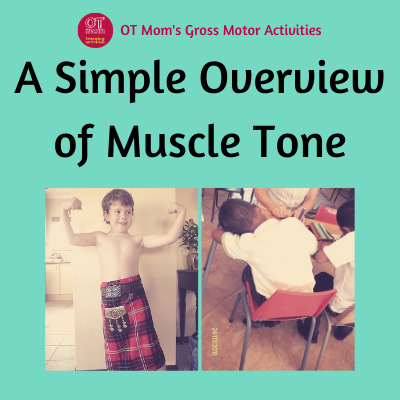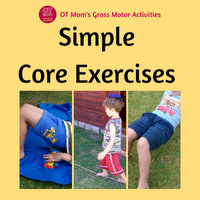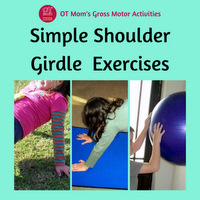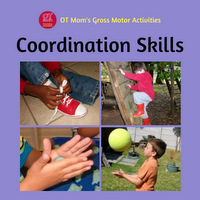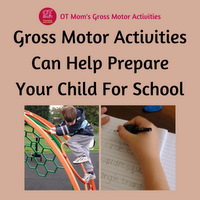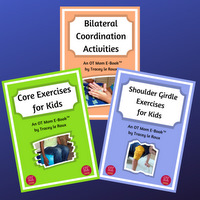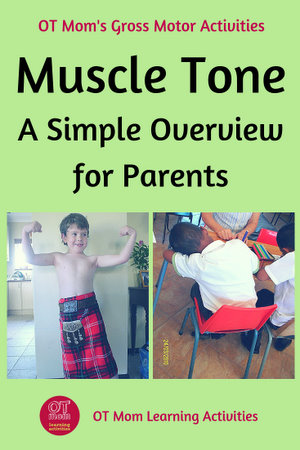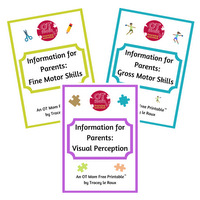- Home Page
- Gross Motor Skills Explained
- An Overview of Muscle Tone
What Is Muscle Tone?
"What is muscle tone?" is a question that parents and teachers often ask their child's physical and occupational therapist. It is a term that is widely used in pediatric circles but there is often some confusion about what it means.
Many people confuse muscle tone with muscle strength.
On this page, I have written a simplified overview and a brief description of normal, high
and low muscle tone and how low muscle tone can affect a child's functioning in the classroom and in life.
I sometimes link to products (#Ad) that are similar to those I use and love. If you do purchase something through my links, I will receive a small commission that helps support my site - thank you!
What Is Muscle Tone - A Definition
A formal definition of muscle tone is the following:
"the resistance of the muscle to passive elongation or stretching" (Stolov, 1966 1).
In other words, it is the state of muscle tension inside a muscle or muscle group when it is at rest.
It is important to remember that muscle tone is on a continuum – you can have normal muscle tone that is a bit on the low side or a bit on the high side which does not affect your functioning.
The rest of my article will hopefully explain this definition to make it easier to understand!
Normal Muscle Tone
Normal tone means that there is the right amount of “tension” inside the muscle at rest, and that the muscle is ready and able to contract on command.
In other words, you can “tell” your muscle to do what you want, when you want, with the appropriate amount of force.
An Example of Normal Muscle Tone While Reaching For A Cup Of Coffee
Here is an everyday example of how the tone in your muscles affects you when reaching for a cup of coffee!
Imagine you are sitting in your armchair, arms resting on your lap (your arm muscles are “at rest”). You decide to have a sip of your coffee, which is on the table next to you. With your normal muscle tone, you reach out with your arm, your hand connects with your cup of coffee, grasps it with just the right amount of pressure, and you bring it back to your mouth. No spills, no fuss!
Your muscles did exactly what you wanted them to do, at exactly the right speed, with the right amount of force, without wasting energy or effort.
High Muscle Tone
High muscle tone means there is too much tension in the muscle at rest. In other words, the muscle is tight and tense even though it is not doing anything.
A
child with spastic cerebral palsy may have high tone, which causes the
arms and legs to be tightly contorted. When the arms and legs are not
regularly stretched and moved through physical therapy, then
“contractures” of the muscles may occur, which mean the child is less able to stretch out the arms and legs to the full extent.
An Example of High Muscle Tone While Reaching For A Cup Of Coffee
If you had increased tone in your muscles, and wanted to reach out for your cup of coffee, you would have to concentrate very hard and expend a lot of effort overcoming the tension in your biceps in order to stretch out your arm.
You may well end up moving your whole body towards the coffee to try and reach it, as the tension in your arm muscles is too high to be overcome with ease. Your movements are also likely to be jerky and uncontrolled while reaching for the coffee and while bringing it back to your mouth.
The result is likely to be spilled coffee.
Low Muscle Tone
Low muscle tone means there is not enough tension in the muscle when it is at rest.
The muscle may have a slightly mushy or floppy feel to it, and there is a lack of graded control of the muscle when it is being used (graded control means that just the right amount of movement and effort is used as appropriate to the task at hand).
An Example of Low Muscle Tone While Reaching For A Cup Of Coffee
When you decide you want to have a sip of coffee, having low muscle tone means there is not enough tension in your muscles at rest. So you use a bit extra momentum to get your hand to where you want it to be, maybe by flinging your arm out towards the cup.
You bump the cup a bit, get your
fingers around the handle and then drag it back, but the cup is heavy,
and you use too much oomph at first (to overcome the lack of “tension”
in your muscles) with the result that the coffee sloshes out. You may also struggle to keep the cup in the air all the way to your mouth, resulting in holsing your arms close to your body and crouching over the cup to try and take your sip.
Your low muscle tone resulted in clumsiness and a lack of control in doing what you wanted to do.
It is important to remember that muscle tone is on a continuum – you can have normal muscle tone that is a bit on the low side or a bit on the high side which does not affect your functioning.
The Effect of Low Muscle Tone
Muscle tone affects postural control and postural stability.
Postural control and postural stability give you the “background” control of your body that is necessary for helping you to stay upright and to stabilize you during movement.
Children with low muscle tone may battle to sit upright for any period of time, and may slouch over their school desk like the child in this picture who is trying to draw.
They may also lack endurance in gross and fine motor activities and they may struggle with games that require coordinated, controlled movements.
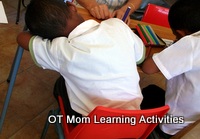 Slouching because of low muscle tone
Slouching because of low muscle tonePostural stability needs to develop in 3 main areas:
- Neck muscles
- Shoulder girdle muscles
- Core muscles (trunk muscles)
If your child lacks good postural stability, then gross motor, fine motor, and coordination skills may be affected.
Please contact your health professional if you have any concerns about your child's muscle tone, postural control or any other aspects of development. This webpage serves to inform, not to diagnose.
If you are looking for activities to promote your child's optimal gross motor development on the normal continuum of muscle tone, then keep reading - the next section will help you!
Helpful Activities
Many children in this modern era are not getting enough exposure to gross motor activities in order to develop the postural stability and postural control that is needed for formal schooling.
Adequate shoulder girdle stability and core stability are one of the important foundations for good fine motor development.
If you are looking for gross motor activities to promote your child's optimal development, then check out these pages of my site for some free, easy activity ideas to strengthen your child's skills:
If you are looking for printable resources that you can refer to over and over again with all your kids, then do check out my affordable gross motor e-books!
These resources each focus on a specific gross motor skill, and provide dozens of pages of photographed activities you can do with your child at home with resources you probably have on hand!
Thank you for visiting my site!
If you have been wondering "What is muscle tone?" then I hope you found this simple description to be helpful. There is much more that can be said, but hopefully this page will enable you to understand the basic concept.
Please do sign up for my occasional newsletter to stay in touch with new pages and updates as they happen.
- Home Page
- Gross Motor Skills Explained
- An Overview of Muscle Tone
Sources:
1) Mathiowetz and Haugen. Evaluation of Motor Behavior: Traditional and Contemporary Views. Occupational Therapy for Physical Dysfunction, Baltimore: Williams & Wilkins, 1995.
Share this page to help others!
Didn't find what you were looking for? Try a search of my site!
